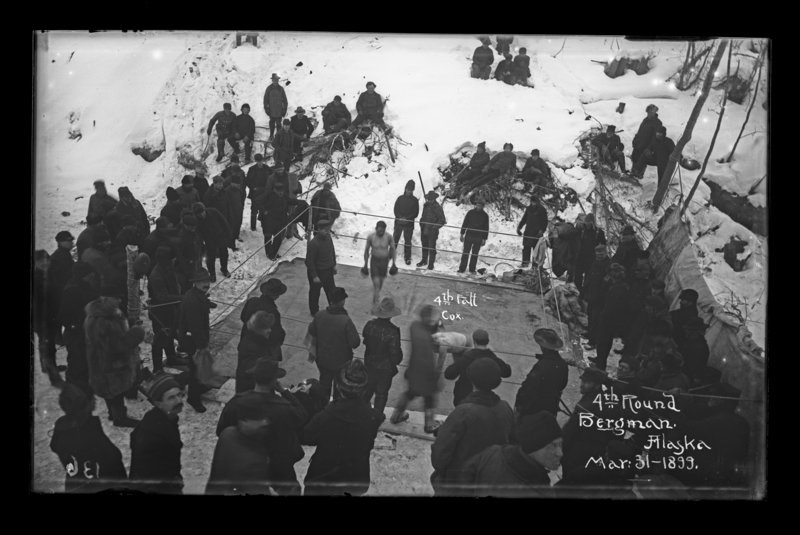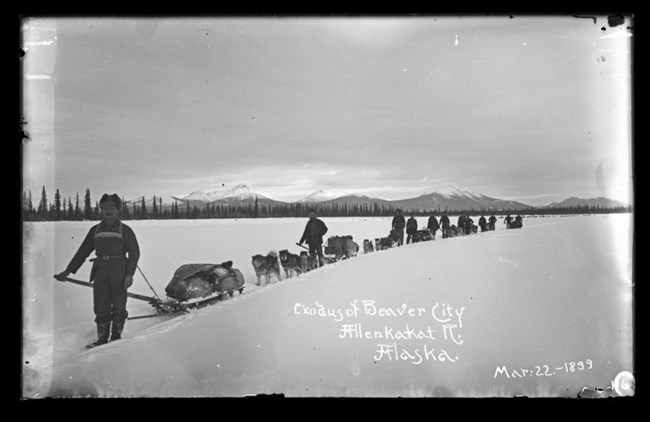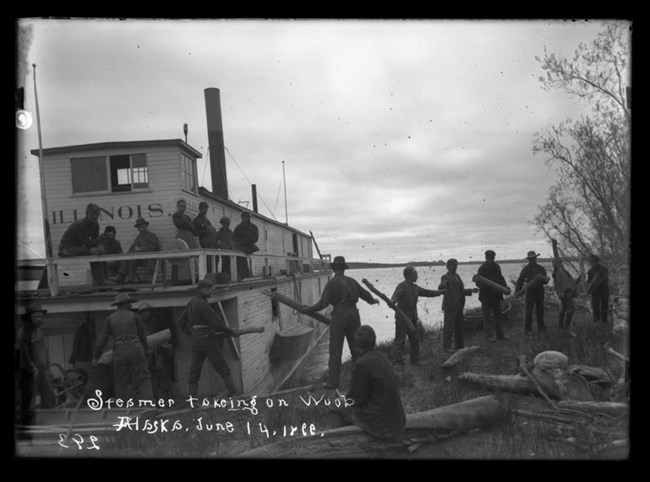|
Frontier Metropolis At Bergman, Wyman joined the crowd to watch a prize fight between Ed Kelly and J.C. Cox, who met in a ring built on the ice near the bank of the Koyukuk. Kelly won the $250 purse when he knocked Cox out in the fifth round. Nearby Arctic City could now boast twenty cabins, a saloon, a dancehall, and a sawmill, and it even had electrical power. By early April other members of the Galesburg company had reached this frontier metropolis, and Wyman took time to make prints of all his pictures for the men in the company. He also made extras to sell there and in Bergman. While in Bergman, Wyman heard about a gold strike on Myrtle Creek near the Middle Fork of the Koyukuk, but like most prospectors in the area he was dubious. He could not have known that this strike and several others would make the Koyukuk a viable mining district for years to come. 
Jasper N. Wyman Collection 
Jasper N. Wyman Collection The Journey Home Back at Beaver City the rest of the Galesburg company began loading the Illinois and moved into the vessel before the river ice had yet broken up. They also tore down their cabins to cut into firewood for the return trip to civilization. For most it had been a disappointing trip, and when breakup arrived on May 26, they were happy to be leaving. The return journey of the Illinois was plagued by the same obstacles that slowed its voyage north the previous fall. On the first day the vessel broke a rudder, landed on two sandbars, and blew a gasket allowing the boiler to lose steam. Only after the company elected Wyman as their new pilot and the vessel entered deeper water did the voyage go more smoothly. Eager to see the end of their Alaska adventure, they raced other steamboats south to the trading post of Koyukuk at the river's mouth and witnessed the mass exodus of disappointed and destitute miners using the Yukon River to return home. 
Jasper N. Wyman Collection As the Illinois steamed toward St. Michael once again, a dozen Galesburg men resigned from the company and drew out their share of the company's provisions. Most of them signed on for work with the Alaska Commercial Company so that they could remain in the northland and perhaps make their fortunes yet. At St. Michael the town was buzzing with news of gold at Cape Nome to the northwest on the Seward Peninsula, and Wyman and the remaining Galesburg men had no trouble selling off their remaining supplies. The new stampede to Nome would draw thousands away from the Klondike, the Koyukuk, and other lesser gold fields and would extend the great Klondike-Alaska Gold Rush for a few more years. For his part, Wyman soon booked passage to Seattle on a freighter, and fourteen months after leaving, he was back in Seattle where he bought new clothes and had a bath before boarding a train back to Illinois. Sources: Aurlette D. Ingman, Gold Dust [unpublished novel based on Wyman journals], 1938. Jasper N. Wyman Photograph Collection, Anchorage Museum of History and Art, Anchorage, Alaska. Journey to the Koyukuk: The Photos of J. N. Wyman, 1898-1899 (Missoula, MT: Pictorial Histories Publishing Co., 1988). Rex Cherrington, "The Galesburg Alaska Mining and Developing Company Left Galesburg One Hundred Years Ago" [online article], 1998. |
Last updated: April 14, 2015
